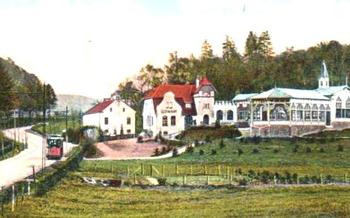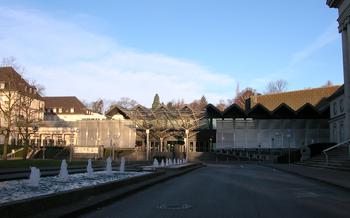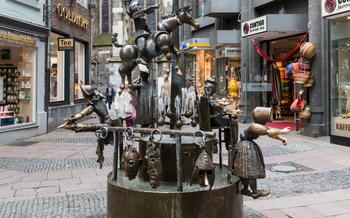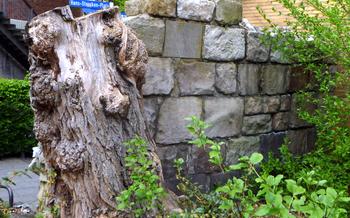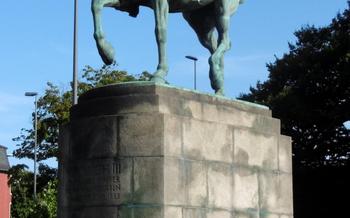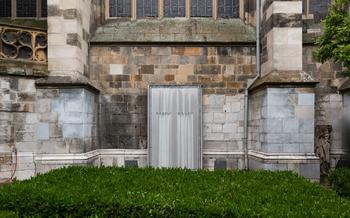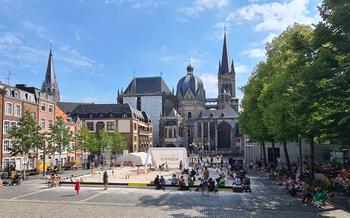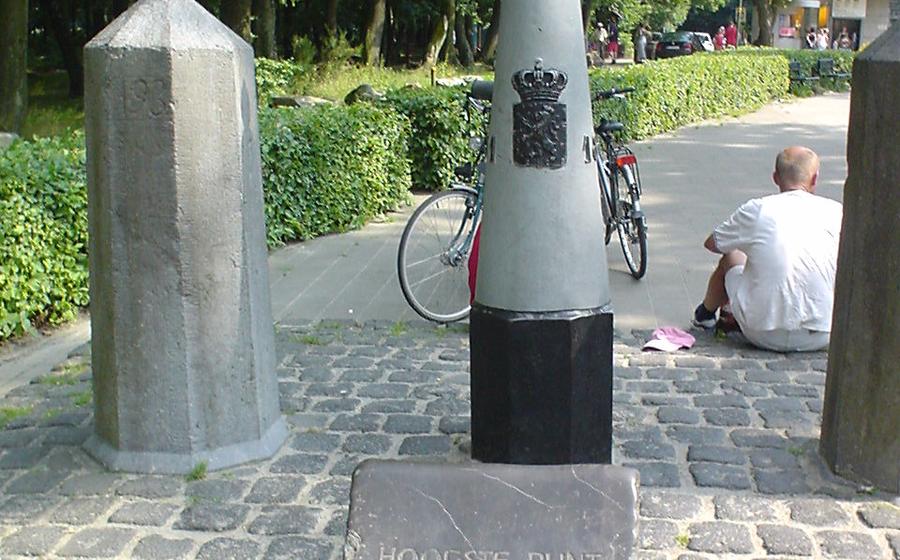
Vaalserberg – The highest point in the Netherlands, close to Aachen
- Aachen's Proximity to the Netherlands
- Introduction to Vaalserberg
- Planning Your Visit
- The Three-Country Point (Drielandenpunt)
- Hiking Trails and Nature
- The Labyrinth
- The Aachener Wald
- The Preuswald
- The Eifel National Park
- The Aachen Cathedral: A Majestic Symbol of History and Faith
- Insider Tip: The Panoramaweg Trail for a Unique Perspective
Aachen's Proximity to the Netherlands
Aachen, a vibrant city nestled in western Germany, boasts a unique geographical advantage: its proximity to the Netherlands. This close relationship between the two countries extends beyond mere borders; it's a tapestry of shared history, culture, and a seamless flow of people and ideas.
Crossing the border from Aachen into the Netherlands is a breeze, offering a chance to explore the diverse landscapes and rich heritage of our Dutch neighbors. The border region is a melting pot of cultures, where German efficiency meets Dutch gemütlichkeit, creating a harmonious blend that's both intriguing and welcoming.
As you venture into the Netherlands, you'll notice subtle shifts in language, architecture, and culinary delights. The Dutch language, with its distinct guttural sounds, may initially sound foreign, but it's not uncommon to find locals who speak both German and English fluently, making communication a breeze.
The architectural styles in the border region are a testament to the blending of cultures. Traditional German half-timbered houses stand side by side with Dutch brick-built gabled houses, creating a visually captivating streetscape.
And let's not forget the cuisine! German hearty dishes like schnitzel and sauerkraut harmoniously coexist with Dutch delicacies such as poffertjes and stroopwafels, offering a culinary adventure for every palate.
Introduction to Vaalserberg
Vaalserberg, located on the border of Germany and the Netherlands, holds the distinction of being the highest point in the Netherlands, standing at a modest 325 meters (1,058 feet) above sea level. Its geographical significance stems from its unique position, where the borders of Germany, Belgium, and the Netherlands meet. This convergence of three countries has given rise to the symbolic Three-Country Point (Drielandenpunt), a popular destination for visitors seeking a unique cross-border experience.
Vaalserberg has a rich history, dating back to Roman times when it was known as Mons Alti (High Mountain). Its strategic location made it a desirable spot for settlements and fortifications throughout the centuries. In the Middle Ages, it was part of the Duchy of Limburg, and later became a possession of the Holy Roman Empire.
Despite its relatively small size, Vaalserberg boasts a diverse flora and fauna. The hill's unique microclimate supports a variety of plant species, including orchids, ferns, and mosses. The surrounding forests are home to a variety of animals, including deer, foxes, and badgers.
Interesting Facts about Vaalserberg:
- Vaalserberg is the only hill in the Netherlands that has a border stone marking the exact point where three countries meet.
- The hilltop features a 50-meter-tall observation tower offering panoramic views of the surrounding countryside.
- Vaalserberg is a popular spot for paragliding and hang gliding due to its favorable wind conditions.
- The hill is also home to a labyrinth, a popular attraction for visitors seeking a unique and challenging experience.
Planning Your Visit
To make the most of your journey to Vaalserberg, careful planning is essential. The ideal time to visit is during the spring (April-May) or autumn (September-October) when the weather is pleasant and the crowds are smaller. Summer (June-August) can be warm and busy, while winter (November-March) can be cold and snowy, affecting the accessibility of some trails.
Transportation options from Aachen are convenient and varied. Regular buses depart from Aachen's central bus station, taking approximately 30 minutes to reach Vaalserberg. Alternatively, you can rent a car for greater flexibility, allowing you to explore the surrounding area at your own pace.
For those planning an extended stay, there are several accommodation options in the vicinity of Vaalserberg. Quaint bed and breakfasts, cozy guesthouses, and modern hotels offer a range of choices to suit different budgets and preferences.
When packing for your visit, be sure to include comfortable hiking shoes or boots, as well as layers of clothing to accommodate changing weather conditions. Sunscreen, insect repellent, and a water bottle are also essential companions for your outdoor adventure.
The Three-Country Point (Drielandenpunt)
At the summit of Vaalserberg lies a unique convergence of three nations: Germany, Belgium, and the Netherlands. This extraordinary meeting point is known as the Drielandenpunt and is marked by an iconic monument that symbolizes the harmonious coexistence of these neighboring countries. The monument, featuring three interlocking rings, represents the unity and cooperation among the three nations.
Historically, the Three-Country Point has held significant importance as a crossroads for trade, travel, and cultural exchange. In the past, the convergence of these three countries facilitated the movement of people and goods, contributing to the region's economic and cultural development. Today, the Drielandenpunt serves as a symbol of unity and cooperation, reminding visitors of the interconnectedness and shared history of these three European nations.
Cultural events and celebrations are often held at the Three-Country Point, showcasing the diverse traditions and heritage of the region. These events provide an opportunity for visitors to experience the unique blend of cultures that converge at this special location. Whether it's a traditional Dutch cheese market, a Belgian beer festival, or a German music concert, the Three-Country Point offers a vibrant and multicultural atmosphere that celebrates the unity and diversity of the region.
Hiking Trails and Nature
The area surrounding Vaalserberg is a haven for hiking enthusiasts, with an extensive network of trails catering to various difficulty levels and distances. These trails meander through dense forests, picturesque valleys, and rolling hills, offering breathtaking views of the surrounding countryside.
The Three-Country Point Trail is a popular choice, taking hikers past the symbolic monument marking the convergence of Germany, Belgium, and the Netherlands. The panoramic views from the top of Vaalserberg are simply stunning, allowing you to admire landmarks in all three countries.
For those seeking a more challenging hike, the Eifelsteig Trail offers a 313-kilometer-long adventure through the Eifel National Park. This long-distance trail traverses diverse landscapes, including ancient beech forests, volcanic craters, and charming villages.
Nature lovers will delight in the diverse flora and fauna found in the Vaalserberg area. The forests teem with wildlife, including deer, wild boar, and a variety of bird species. Keep an eye out for rare orchids and other wildflowers that bloom in abundance during the spring and summer months.
Whether you're a seasoned hiker or simply seeking a leisurely stroll in nature, the trails surrounding Vaalserberg offer something for everyone. Embrace the tranquility of the forest, breathe in the fresh air, and let the beauty of the natural surroundings rejuvenate your soul.
The Labyrinth
Amidst the natural wonders of Vaalserberg lies a unique and intriguing attraction: the labyrinth. This intricate maze of paths and turns has captivated visitors for generations, offering a challenging and thought-provoking experience.
The labyrinth's history is shrouded in mystery, but it is believed to have been constructed in the early 20th century as a symbol of unity and cooperation between the three neighboring countries. The design of the labyrinth is based on ancient Celtic and Germanic traditions, representing a journey of self-discovery and transformation.
Navigating the labyrinth requires patience, perseverance, and a keen sense of direction. As you wind your way through the maze, you'll encounter dead ends, false turns, and moments of confusion. But with each step, you'll also gain a deeper understanding of yourself and your ability to overcome challenges.
The labyrinth is more than just a physical puzzle; it's a metaphor for life's journey. It reminds us that the path to our goals is often filled with twists and turns, but with determination and self-belief, we can eventually find our way.
For those seeking a unique and introspective experience, the labyrinth at Vaalserberg is a must-visit. Whether you choose to walk it alone or with companions, the journey through the labyrinth will leave you with a sense of accomplishment and a renewed perspective on life's challenges.
The Aachener Wald
The vast Aachener Wald, also known Belgium. This expansive forested area offers a tranquil escape from the urban bustle of Aachen and is a haven for nature enthusiasts and outdoor adventurers.
The Aachener Wald is home to a diverse array of flora and fauna, including ancient tree species that have stood tall for centuries. Visitors can wander through the forest on a network of well-marked hiking trails, ranging from easy strolls to challenging climbs, and immerse themselves in the serene beauty of nature.
For those seeking a more active experience, the Aachener Wald offers a variety of cycling routes that wind through the forest, providing a chance to explore its hidden corners and discover picturesque viewpoints. Mountain bikers will find plenty of adrenaline-pumping trails that test their skills and endurance.
Whether you're a seasoned hiker, an avid cyclist, or simply seeking a peaceful retreat in nature, the Aachener Wald has something to offer everyone. Embrace the tranquility of the forest, breathe in the fresh air, and let the beauty of nature rejuvenate your soul.
The Preuswald
Adjacent to the Aachener Wald lies the Preuswald, a nature reserve renowned for its unique geological formations and rare plant species. Its diverse landscape, featuring steep slopes, deep ravines, and hidden valleys, offers a haven for nature enthusiasts and outdoor adventurers.
The Preuswald is a treasure trove of geological wonders. Its distinctive sandstone formations, shaped by millions of years of erosion, create a captivating landscape. Visitors can explore the reserve's many hiking trails, which wind through narrow gorges and past towering rock faces, offering breathtaking views and a glimpse into the Earth's ancient history.
The Preuswald is also home to a rich diversity of flora and fauna. The reserve's unique microclimate supports a variety of plant species, including rare orchids and ferns. Birdwatchers will delight in the opportunity to spot a variety of feathered friends, including woodpeckers, nuthatches, and the elusive European honey buzzard.
For those interested in wildlife photography, the Preuswald provides ample opportunities to capture stunning images of the reserve's inhabitants. From the vibrant colors of butterflies fluttering through the undergrowth to the majestic flight of birds of prey soaring overhead, the Preuswald offers a feast for the senses and a chance to document the beauty of nature.
Whether you're a seasoned hiker, an avid birdwatcher, or simply someone who appreciates the wonders of the natural world, the Preuswald is a must-visit destination. Its unique geological formations, diverse flora and fauna, and serene atmosphere make it an ideal place to escape the hustle and bustle of everyday life and reconnect with nature.
The Eifel National Park
A short journey from Aachen lies the Eifel National Park, a breathtaking expanse of unspoiled wilderness that showcases the region's rich volcanic heritage, dense forests, and a tapestry of cultural treasures. Established in 2004, this national park encompasses over 100 square kilometers of diverse landscapes, inviting outdoor enthusiasts, nature lovers, and history buffs to explore its many wonders.
Within the park's boundaries, ancient volcanic craters, known as maars, tell the story of the region's fiery past. Lush forests, teeming with diverse flora and fauna, cloak the rolling hills, providing refuge for rare and endangered species. Hikers can embark on a network of well-marked trails that wind through the park's varied terrain, while cyclists can pedal along scenic routes, immersing themselves in the tranquility of the natural surroundings.
Beyond its natural beauty, the Eifel National Park is steeped in cultural heritage. Scattered throughout the park are remnants of ancient Roman settlements, medieval castles, and charming villages that whisper tales of a bygone era. Visitors can delve into the region's rich history by exploring these historical sites, each offering a glimpse into the lives and traditions of those who came before.
The Aachen Cathedral: A Majestic Symbol of History and Faith
In the heart of Aachen, just a short drive from Vaalserberg, stands a magnificent architectural marvel, the Aachen Cathedral. This awe-inspiring edifice, designated as a UNESCO World Heritage Site, holds immense historical and religious significance. As the coronation church for Holy Roman Emperors, the cathedral has witnessed centuries of imperial ceremonies and played a pivotal role in shaping the course of European history.
Its origins can be traced back to the 8th century when Charlemagne, the first Holy Roman Emperor, commissioned its construction. Over the centuries, the cathedral underwent several expansions and modifications, resulting in a harmonious blend of architectural styles, from Carolingian to Gothic. The Palatine Chapel, the oldest part of the cathedral, is a masterpiece of Carolingian architecture, featuring intricate mosaics and stunning vaulted ceilings.
As you step inside the cathedral, you are transported back in time. The grand interior is adorned with opulent decorations, intricate carvings, and stained-glass windows that bathe the space in a kaleidoscope of colors. The intricate bronze doors, known as the "Wolf Doors," are particularly impressive, depicting scenes from the Old Testament. The cathedral's treasury houses a collection of priceless artifacts, including the Charlemagne Shrine, a magnificent reliquary crafted in gold and silver.
Visiting the Aachen Cathedral is an unforgettable experience that combines history, art, and spirituality. Take your time to explore its every nook and cranny, marveling at the exquisite craftsmanship and the rich symbolism that adorns its walls. Whether you are a history buff, an architecture enthusiast, or a pilgrim seeking spiritual solace, the Aachen Cathedral will undoubtedly leave a lasting impression on your soul.
Insider Tip: The Panoramaweg Trail for a Unique Perspective
For an unforgettable experience, venture off the beaten path and embark on the Panoramaweg trail, which starts near the Drielandenpunt. This scenic trail offers breathtaking views of the surrounding countryside, allowing you to appreciate the region's natural beauty from a unique perspective. As you hike along the well-marked paths, you'll encounter panoramic vistas that stretch across Germany, Belgium, and the Netherlands.
Along the way, take a moment to pause at the Wilhelmina Tower, a historical monument that provides an even more elevated vantage point. From the tower's observation deck, you can marvel at the stunning landscape, dotted with charming villages, rolling hills, and lush forests.
Whether you're an avid hiker or simply seeking a tranquil escape, the Panoramaweg trail promises an unforgettable adventure. Embrace the opportunity to explore this hidden gem and create lasting memories in this picturesque corner of Europe.
